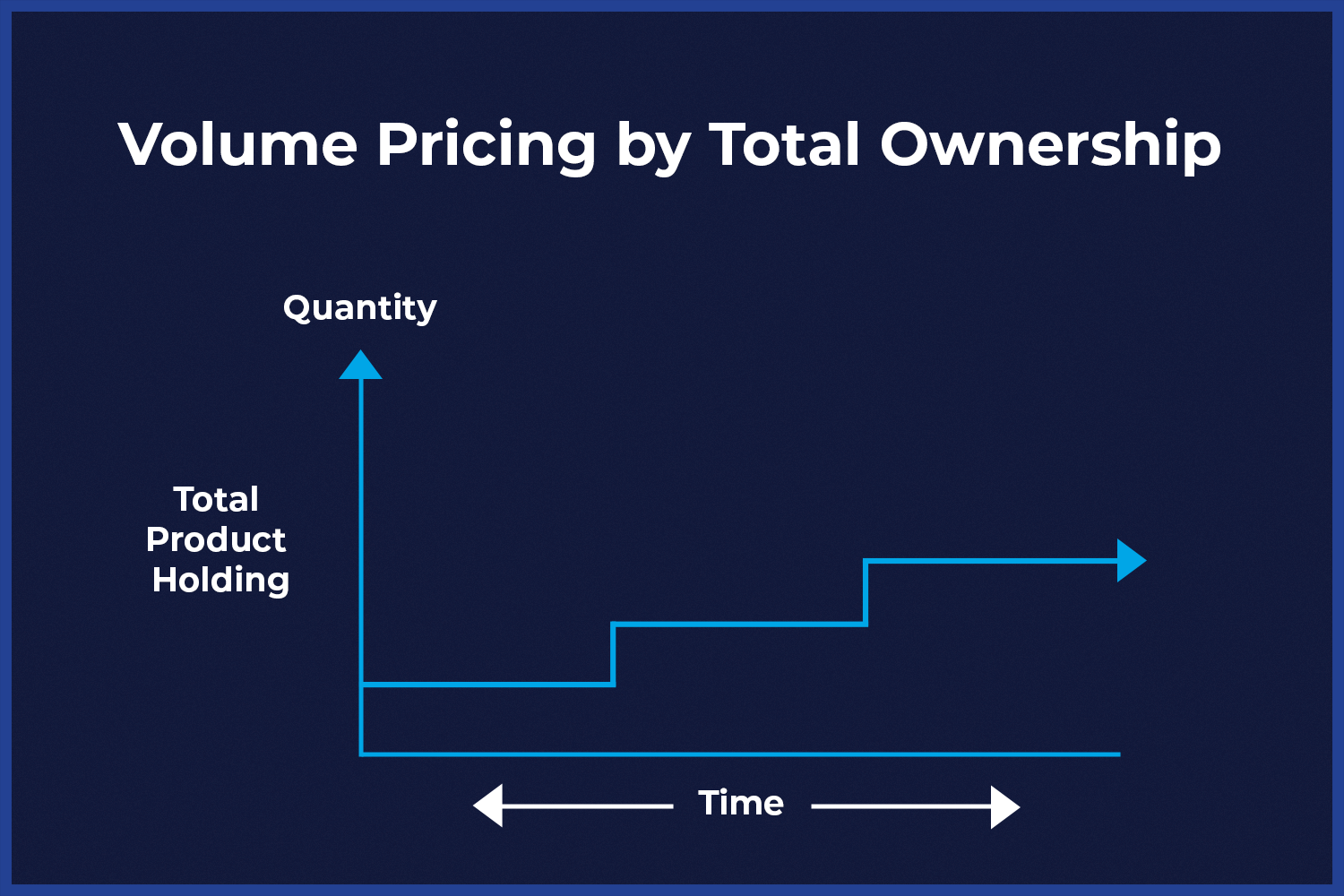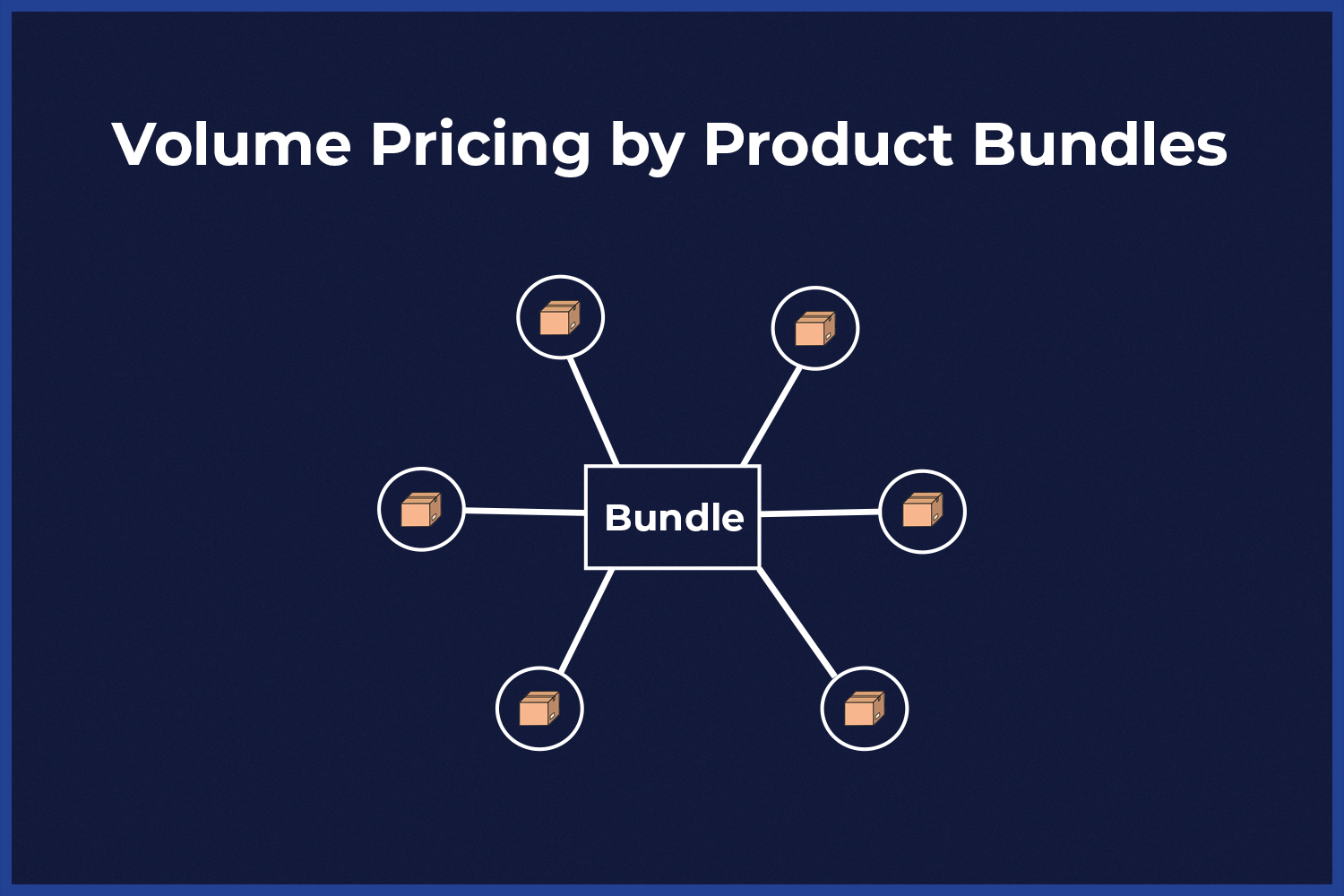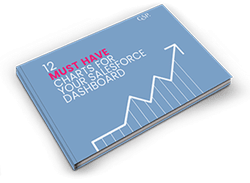Volume-Based Pricing: Which of the Following 5 Volume Pricing Strategies Works Best for You?
Bonus! Includes Volume Pricing Examples and Practical Guidance on Implementing Volume Pricing in Salesforce Without CPQ
Last updated December 22, 2025
At a Glance
Volume-based pricing is widely used by B2B companies, but Salesforce doesn’t offer it out of the box without CPQ or Revenue Cloud. This guide outlines the five main types of volume pricing - bands, tiers, increments, total ownership, and product bundles – along with their advantages and disadvantages, and how to implement a flexible, cost-effective volume pricing strategy directly within Salesforce.
Volume pricing or quantity-based discounts exist in almost every industry. While Salesforce doesn't offer volume discounts as a standard feature - unless you're willing to invest in an expensive and complex CPQ system - there's good news.
In this guide, I’ll break down what volume-based pricing is, why businesses use it, and the five most common volume pricing methods. Finally, I’ll show you how to implement volume pricing and product bundles in Salesforce using GSP apps.
What is Volume-Based Pricing?
Volume-based pricing or discounting (also known as quantity-based pricing or discounting) is a product pricing strategy in which the amount charged to the customer decreases, depending on the size or quantity of the purchase.
In other words, the more the customer buys, the greater the discount and the lower the unit price. Companies often express the discount and reduction in unit price arising from volume pricing as a percentage or monetary discount from the list price (the list price is the standard price charged for a product or service, assuming no discount).
Complex volume pricing mostly occurs in business-to-business (B2B) transactions, rather than the more straightforward discounts often found in the retail or business-to-consumer (B2C) sectors, such as 20% off today or buy-one-get-one-free.
Why Do Companies Offer Volume Discounts?
Businesses primarily offer volume discounts to customers to encourage and incentivize increased purchasing behavior.
Depending on the structure of the quantity-based discount strategy, the incentive can relate to individual deals or encourage customers to increase their total product acquisition over time.
Volume discounts can also be used for a limited time to support seasonal campaigns or other promotion types. In some circumstances, companies may offer volume discounts temporarily to help remove out-of-date or older stock.
What are the Most Common Mistakes Companies Make with Volume Pricing?
The top five mistakes companies make with volume pricing are:
- Rogue discounts. Salespeople offer vague or negotiable discounts without referencing the predefined volume pricing calculation.
- Ignoring fulfilment costs. Discounts and volume pricing calculations often overlook the fulfillment or support costs associated with different channels or customer segments.
- Not updating volume discounts. Companies often persist with the same volume pricing discounts, even though market dynamics and their competitive position have changed.
- Too many exceptions. Salespeople often request additional discounts on almost every deal; sales leaders too easily acquiesce to these requests, particularly at the end of the month or quarter.
- Poor customer communication. Customers often fail to understand the volume pricing discounts available, resulting in protracted negotiations and extended sales cycles.
Calculating volume pricing in Salesforce enables managers to exert more control in many of these areas, particularly if you apply our discount approval recommendations.
Types of Volume Pricing and Discounts
There are five common ways that companies structure volume pricing strategies:
- Bands
- Tiers
- Increments
- Total ownership
- Product bundles
This next section explains what each volume pricing strategy means, where they’re commonly found, and their pros and cons.
1. Volume Pricing by Bands
With volume discounts by bands, customers pay the same price for all units, with the band determining the price.
For example, your pricing table for a product may look like this:
| Product Name: XYZ | Sales Price Per Unit |
| 1 to 10 units | $100 |
| 11 to 30 units | $95 |
| 31 to 100 units | $90 |
| and so on. |
Using the pricing table above as an example, if the customer buys 25 units, the unit price for the entire purchase is $95. Alternatively, if they buy 35 units, the unit price drops to $90.
In other words, the salesperson bases the price for the entire product quantity on the relevant band. Of course, if the customer purchases multiple products, each item can have a separate set of price bands.
Where Is Band-Based Volume Pricing Usually Applied?
Band-based discounting is the most common form of volume pricing, and many companies and industries use it.
For example, many manufacturing businesses offer unit price reductions based on the volume or quantity purchased. These arrangements can relate to one-off transactions or be integral to framework arrangements that last over a period.
Pro-tip. If your business uses framework agreements, then you'll likely get value from this article:
4 Types of Framework Agreements You Can Manage in Salesforce
Advantages of Volume Pricing by Bands
The benefits of using volume pricing by bands compared to the other quantity-based discount methods are:
- Easier for the customer to understand.
- More straightforward for salespeople to calculate the product price and discount.
- Easier to communicate in customer-facing information.
Disadvantages of Volume Pricing by Bands
The disadvantages of volume pricing by bands compared to the other quantity-based discount strategies are:
- Lower average unit price and reduced margin.
A band-based approach to quantity pricing encourages customers to purchase higher volumes to benefit from a reduced price. On the other hand, the average unit price is reduced because the lower price applies to ALL units.
Consequently, the margin per unit is lower, and the total margin on the deal is reduced compared, for example, to volume pricing by tiers.
2. Volume Pricing by Tiers
The customer pays a different price for each tier with tier-based volume pricing.
For example, the individual tiers may look the same for bands in the pricing table. But here's the key difference: with band-based pricing, the customer pays the same price for all units within a band. In tier-based pricing, the customer pays one unit price for the first tier, a different unit price for the second tier, and so on.
| Product Name: XYZ | Sales Price Per Unit |
| 1 to 10 units | $100 |
| 11 to 30 units | $95 |
| 31 to 100 units | $90 |
| and so on. |
In this example, let’s say the customer is buying 35 units. They will pay $100 for 1 to 10 units; $95 for units 11 to 30; $90 for units 31 to 100, and so on. As a result, the average unit price is higher than band pricing when there is an equivalent set of thresholds and discount percentages.
Consequently, the opportunity has a higher total margin with tier-based discounts than band-based discounts.
Where Is Tier-Based Volume Pricing Usually Applied?
Like band-based discounting, volume pricing by tiers is used widely across many companies and industries.
For example, many software, data storage, and SaaS businesses use tiers to offer pricing and discount thresholds.
That said, tier-based pricing is less common than band-based pricing and less popular with customers because it's significantly harder for salespeople to calculate the correct price and for customers to understand the pricing strategy easily.
Advantages of Volume Pricing by Tiers
The benefits of using volume pricing by tiers compared to band quantity-based discount methods are:
- Higher overall unit price and therefore increased margin.
- Avoid situations where a slight increase in quantity reduces the overall unit price. In other words, the tiers' approach to volume-based pricing means customers cannot initiate a lower average price through a slight increase in quantity.
Disadvantages of Volume Pricing by Tiers
The disadvantages of volume pricing by tiers compared to band quantity-based discount strategies are:
- It is more difficult for the customer to understand how the final unit price was determined.
- It is more difficult for salespeople to calculate the product price and discount, especially without an appropriate pricing tool.
- It is harder to communicate during sales dialogue or customer-facing documents.
3. Volume-Based Pricing by Increments
The incremental approach to volume-based pricing is a more sophisticated version of tiers.
Incremental pricing means the unit price is slightly lower for each reduction in quantity of one. (Tier-based pricing has larger quantity ranges that differentiate each discount threshold.)
Here's an example of volume pricing using the incremental approach:
| Quantity | Unit Price |
| 1 | $100 |
| 2 | $99 |
| 3 | $98 |
| 4 | $97 |
| 5 | $96 |
| 6 | $95 |
| And so on |
In this example, you can see that, as with most incremental pricing arrangements, the reduction in unit cost is slight with each increase in quantity.
Where Is Incremental Volume Pricing Usually Applied?
Incremental pricing is significantly less common than band or tier quantity-based discounting. It's used primarily by companies that sell a high volume of relatively small items.
For example, some companies in the business education sector use incremental pricing to calculate the cost of places on training courses or exams. In these cases, the unit price reduces slightly for every additional person a company enrolls in a course or registers for an exam.
In these businesses, the cost of running the training course and fulfilling the service is competitively fixed. Therefore, once the course has enough delegates to cover the fixed costs, the margin on every incremental attendee delegate is high; adding a small number of additional attendees significantly boosts the overall profitability of the training course. Incremental pricing is one tool these companies use to drive extra course attendees.
Advantages of Volume Pricing by Increments
The benefits of using volume pricing by increments compared to band quantity-based discount methods are:
- Higher overall margin compared to other pricing options.
- Customers are encouraged to purchase additional, high-margin products or services.
Disadvantages of Volume Pricing by Increments
The disadvantages of using volume pricing by increments compared to band quantity-based discount methods are:
- It is more challenging for salespeople and customers to easily calculate or communicate the overall price (at least without an automated pricing tool).
- Additional maintenance work for system administrators and product managers, particularly when you want to increase (or reduce) prices.
4. Volume-Based Pricing by Total Ownership
With standard band, tier, and increment approaches to volume pricing, the price is determined by the quantity of product or service purchased on a single opportunity or sales deal.
However, volume pricing by total ownership means businesses calculate the price using the customers' overall product holdings. Customers may have acquired this holding through multiple historical opportunities and purchasing transactions.
As such, volume pricing by total ownership is a variant of band or tier-based discounting, i.e., the total quantity of product purchased over time determines the relevant band or tier threshold that applies to an opportunity.
Where Is Total Ownership Volume Pricing Usually Applied?
Many software or SaaS businesses use the customers' total product holding to determine the band or threshold for new opportunities.
This approach means the customer gets a significantly higher discount than would be the case if the pricing were based on the number of licenses purchased on an isolated opportunity.
For example, if you have 100 Salesforce licenses and need to purchase ten more, you'll negotiate the price based on your total product holdings of 110. This approach will likely produce a higher discount than a new customer purchasing ten licenses.
In many cases, companies will agree at the outset on the volume discounts that apply as the customer increases their product holding over time, rather than negotiating on a deal-by-deal basis.
Advantages of Volume Pricing by Total Ownership
The benefits of using volume pricing by total ownership are:
- Customers are incentivized to increase or upgrade their product holding because they know a significant discount applies to a relatively small purchase.
- Clarity on future prices and margins, along with fewer protracted negotiations, assuming discounts are agreed upfront.
Disadvantages of Volume Pricing by Total Ownership
The disadvantages of using volume pricing by total ownership are:
- Reduced margin on additional product purchases (although that may be difficult to avoid).
- Calculating and quantifying the customer's existing product holding requires a robust approach. In some businesses, this may be more difficult than it sounds!
5. Volume-Based Pricing by Product Bundles
Product bundles enable customers to purchase multiple products in exchange for a discount or other benefits. Bundling and grouping products is a variation of volume pricing, as it often motivates customers to increase their spending for a reduced total price or other benefits.
For example, a product bundle may contain five products. The customer agrees to buy all five via a product bundle or package rather than purchasing four products as individual items.
Where Is Product Bundling Usually Applied?
Product bundling happens in almost every industry. It is especially beneficial for customers who need to purchase multiple products or components to meet their needs. Bundling or grouping these products into holistic solutions makes the customer purchasing process easier.
For example, many telecommunications companies offer customers a variety of bundles involving landlines, mobile phones, data services, and support options.
These bundles are often presented on websites and other communications as low-cost, high-cost, and most popular options.
Advantages of Volume Pricing by Product Bundles
The benefits of offering discounts using product bundles are:
- Increased average deal size when customers take up bundles.
- Ease of purchase and sales cycle when customers need to buy multiple products or components as part of an overall solution.
- Improved sales efficiency if salespeople can add product bundles to opportunities rather than searching for multiple individual products.
Disadvantages of Volume Pricing by Product Bundles
The disadvantages of offering discounts using product bundles are:
- Reduced margins if bundles include too many reduced-price or free products.
- Customers may require more flexibility over product selection or different combinations of products than are included in the bundles.
- Allocating bundle revenue back to individual products for margin tracking and revenue recognition can be challenging.
- Risk of poor customer perception if bundles do not offer a worthwhile incentive compared to purchasing products individually or outside of a bundle.
What Is the Best Approach to Volume Pricing?
Several factors influence decisions about the best method for volume pricing or quantity discounts, including:
- Customer expectations based on marketplace practices or the strategies of other suppliers. However, there's no obligation for all companies in the market to adopt the same approach. Differentiating your pricing strategy can provide a competitive sales advantage.
- Integrations with other internal applications, such as ERP systems. These systems may constrain pricing options if they cannot support the invoices or fulfilment resulting from the volume pricing agreement.
- The relationship between fixed and variable product costs. For example, a tier-based approach may be appropriate if a significant fixed cost arises from each deal, but thereafter, a marginal cost applies for each incremental unit. That's because the higher price for the earlier tiers contributes to recovering the fixed cost, but subsequent tiers can be priced more cheaply if no significant additional costs are incurred.
Of course, companies do not always commit to a single volume pricing approach for all products in their range.
How to Implement Volume Pricing in Salesforce
Volume-based pricing in Salesforce is not offered as standard. One option is to purchase a CPQ solution or the Revenue Cloud, however, the cost and effort to implement these solutions often discourage many people.
The GSP Volume Pricing app is a powerful, cost-effective alternative for many companies that is native to Salesforce and quick and easy to implement. It provides out-of-the-box support for volume pricing by bands, tiers, and increments; we can also customize the app to support the total ownership style of volume pricing.
In addition, the Volume Pricing app integrates seamlessly with the GSP Product Manager, which supports product bundles and groups (see section below).
Watch the video below to see how the GSP Volume Pricing app works directly in Salesforce:
This blog post will provide you with more details, plus other videos, on how the app works:
Volume Pricing in Salesforce Made Simple - No CPQ Required
Contact us today if you have questions or want a personalized walkthrough of the Volume Pricing app.
How to Implement Product Bundles in Salesforce
A great way to help salespeople add product bundles and packages to opportunities or quotes in Salesforce is to use the GSP Product Manager.
Similar to the Volume Pricing app, the Product Manager is easy to integrate into your Salesforce environment.
This short video provides an overview of how the Product Manager works:
This video shows how the GSP Volume Pricing and Product Manager apps combine to deliver a complete solution:
Additionally, you can learn more about using product groups and packages in Salesforce by reading the blog post below:
How to Create Product Bundles and Product Groups in Salesforce, Without CPQ
For more information on how the apps work, to request a personalized walkthrough, or to ask any additional questions, contact us now.
Commonly Asked Questions
Additional Resources
- The Power of Pricing - Published in 2003 by McKinsey, this is a great article on the impact (negative and positive) of volume-based pricing (you'll need to register for a free McKinsey account).
- The Low-Risk and Low-Cost Alternatives to CPQ in Salesforce – This blog explains how the GSP Product Manager, Volume Pricing, and Subscription Manager apps combine to create a powerful CPQ alternative for Salesforce users.
- Smarter Product Selection with the GSP Product Manager - This blog post details how the GSP Product Manager enables product bundling and packaging in Salesforce.
- The Essential Guide to Products and Price Books in Salesforce - Wondering how products and price books work in Salesforce? This blog post clearly explains exactly how it works.





